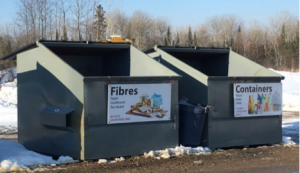The municipality of Hastings Highlands covers nearly 1,000 scenic square kilometres and neighbours the iconic landscapes of Algonquin Park in central Ontario. Like many rural operators, a large component of its Blue Box program costs relate to hauling materials from depot collection sites to distant recovery facilities that often lie more than 100 kilometres away.

Up until recently, the municipality collected recycling in the type of roll-off bins seen at many depots across the province, which provide easy access for residents to deposit recyclables without the use of a platform. The downside is that they tend to be less efficient because there’s no opportunity for compaction of materials, necessitating dedicated runs for each container to local MRFs, when full.
FEL Systems Are Cheaper up Front and a More Efficient Hauling Option
The Hastings Highlands project was the third successful trial of FEL bin systems carried out with CIF support. Other FEL trials were completed in the Township of Madawaska Valley (CIF Project #858) and the Township of Bonnechere Valley (CIF Project #844).

In Hastings Highlands, the FEL system cost nearly $80,000 up front for the purchase of 60 FEL bins, site modifications at all nine depots, and new signage for each bin. The savings of the new system approach nearly $60,000 per year and provide the municipality with a 1.33 year payback on its investment.
What else makes it work?
1. Smart collection leading to full vehicle utilization
In designing the new contract, Hastings Highlands opted to have waste picked up from sites and taken to landfill for disposal and then to have the same truck complete a recycling run on the return trip. Sufficient bins were placed at each site to provide an alternating week collection with fibre collected one week and commingled materials the following week. Together, this resulted in full utilization of the FEL truck and thus low program costs. In comparing the roll-off versus FEL bin systems, Hastings Highlands reduced the number of trips to the MRF by more than half, from 381 to 166.
The FEL bin systems cut the number of trips to the MRF in half!
2. Low upfront capital costs add less depreciation per year to program costs
While the cost efficiency of the new FEL program improved from $540 per tonne to $427 per tonne, it should be noted the $540 per tonne did not include amortization of the roll-off containers as these capital items had been fully depreciated in previous years. Should a complete financial comparison between FEL and roll-off containers be completed the difference in cost savings would be even more drastic.
Key Take-Away – Knock off the Roll-Offs
When available, FEL service offers significant advantages over traditional roll-off methods of depot collection both upfront and over the service life of equipment.
- Site requirements are nominal as collection vehicles and residents can access materials from ground level, with no requirement of expensive saw-tooth infrastructure
- Bins are often 10 times less expensive per unit than their roll-off cousins
- Compaction and the ability to pick up from multiple sites/bins allows FEL trucks to carry maximum payloads, reducing the number of trips to the MRF
- Eye level bin signage reinforces recycling do’s and don’ts for residents, contributing to increased diversion with less contamination
For more information on this project please view the project report and/or email Brad Cutler, CIF Project Coordinator.
